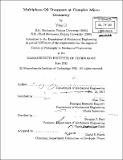Multiphase oil transport at complex micro geometry
Author(s)
Li, Yong, Ph. D. Massachusetts Institute of Technology
DownloadFull printable version (10.03Mb)
Other Contributors
Massachusetts Institute of Technology. Dept. of Mechanical Engineering.
Advisor
Tian Tian.
Terms of use
Metadata
Show full item recordAbstract
Dynamic sealing systems, such as mechanical face seals and piston rings in internal combustion engines are critical components of modern machines. These sealing systems present a unique challenge in controlling the lubricant supply and flow in the contact areas in order to minimize leakage, friction, and wear. Due to the sealing requirement, the minimum oil film thickness is in the order of surface roughness, which is one critical design parameter for the sealing systems. On the other hand, the wavelength of the surface geometrical features ranges from the size of the asperities of the surface roughness, which is in the order of a few microns to the size of the sealing components, which is in the order of millimeters to hundreds of millimeters. It is helpful for engineers to have a good understanding of lubricant transport across a large range of length scales. The aim of this thesis is to establish efficient and robust hydrodynamic lubrication models that are able to handle arbitrary complex geometries, flexible boundary conditions, and penetration of foreign gases. In this thesis, first a general oil transport model was developed. The model considers the variation of oil volume occupation fraction and establishes the dynamic mass flow balance in all locations. Instead of using inefficient small relaxation coefficients to assure convergence, we adjust the local linearization scheme according to local full film or partial film status. The model also applies quick contour detection algorithm to avoid the problems caused by equation's singularity around contact points and slow convergence caused by complex contact patterns. Furthermore, the models can be easily adapted to different scales. With the strong link between the numerical scheme and critical physical processes, the model eases the analysis of complicated results. This model has served as fundamental block of applications that predict and optimize the performance of metal face seals and piston ring pack liner system. Based on the success of single specie two phase oil transport model, a new multi phase oil transport model have been developed with reasonable assumptions about oil/gas mixture coexistence pattern and oil contact pattern. This multi phase model expands our analytical capability to some important but formerly not reachable areas like the starving oil supply boundary condition, pressurized gas boundary condition and the influence of gas penetration to oil film between mechanical components. Some preliminary investigations about the influence of gas penetration to the lubrication of the piston rings in internal combustion engines has been carried out. The results demonstrate that this model is able to preserve the oil mass conservation while capturing the gas penetration, gas pressure variation, and its interaction with the liquid oil. Furthermore, the results show that the liner finish effects becomes more and more prominent when the ring face profile becomes flatter and flatter with either fully-flooded or starved oil supply boundary condition.
Description
Thesis (Ph. D.)--Massachusetts Institute of Technology, Dept. of Mechanical Engineering, 2011. Cataloged from PDF version of thesis. Includes bibliographical references (p. 137-139).
Date issued
2011Department
Massachusetts Institute of Technology. Department of Mechanical EngineeringPublisher
Massachusetts Institute of Technology
Keywords
Mechanical Engineering.